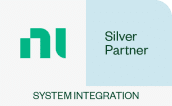NIWeek is much more than just a presentation of new features and products that you can use when solving tomorrow's challenges. It is also a great place to be updated and inspired by other developers, which I will be focusing on in the third and last blog post in the mini-series about NIWeek 2019.
Technical Sessions
In addition to keynotes, NIWeek offers a lot of technical sessions distributed on seven tracks:
- Software Engineering Processes, Architectures, and Design (SEPAD)
- Hardware and Technologies
- Software Fundamentals
- Academic
- Aerospace and Defense
- Automotive
- Semiconductor
Did You Miss NIWeek? [Video]
Thanks to the LabVIEW community, it is still possible to watch some of the technical presentations!
In this post, I will highlight a presentation about how to keep track of your product requirements when using bookmarks in LabVIEW. The presentation was held by Quentin Alldredge from Q Software Innovations and Becky Linton and Chris Beuschell from Konrad Technologies:
Discount on Certifications and Courses [LabVIEW and TestStand]
Did you know that you could take LabVIEW and TestStand certifications at NIWeek? Furthermore, that the price is cheaper than normal? While there was a 50% discount on certification exams, there was a 25% discount on courses.
It was possible to take the following certifications:
- Certified LabVIEW Associate Developer (CLAD)
- Certified LabVIEW Developer (CLD)
- Certified LabVIEW Architect (CLA)
- Certified LabVIEW Embedded Developer (CLED)
- Certified TestStand Developer (CTD)
- Certified TestStand Architect (CTA)
It was possible to attend following courses:
Various Networking Events
A characteristic of NIWeek is also that all participants are represented because they want to learn from each other and build up new relations. This is for instance the case after each presentation, where you can ask questions to the speaker. Questions that often result in professional discussions and networking.
In addition, there is also the exhibition area where sponsors and exhibitors present their latest products, including how these products interact with LabVIEW. For further information about a technical issue, you can also go to the expert bar in order to book a meeting with a LabVIEW expert from NI R&D.
NI was also running an event for the Northern European region, where everybody was invited to dinner for the purpose of networking across countries and companies among others. The conversations were, of course, of a technical nature, but there were also a lot of cock-and-bull stories and funny anecdotes from previous NIWeeks. In addition, one of the major highlights was the final party on Wednesday, where all participants were invited.
A Summary of NIWeek 2019
In conclusion: NIWeek is so much more than just a presentation of new features and future strategies, and I would recommend everybody to attend this event! Personally, it was my first NIWeek, and I want to take the opportunity to thank all of you who have helped making NIWeek amazing!

![Hvad er NIWeek, og hvorfor skal du deltage? [NIWeek 2019 – 3:3]](https://www.gpower.io/wp-content/uploads/2021/08/what-is-niweek-1700x956.webp)
![Nye features i TestStand [NIWeek 2019 – 2:3]](https://www.gpower.io/wp-content/uploads/2021/08/teststand-2019-gpower-1700x956.webp)
